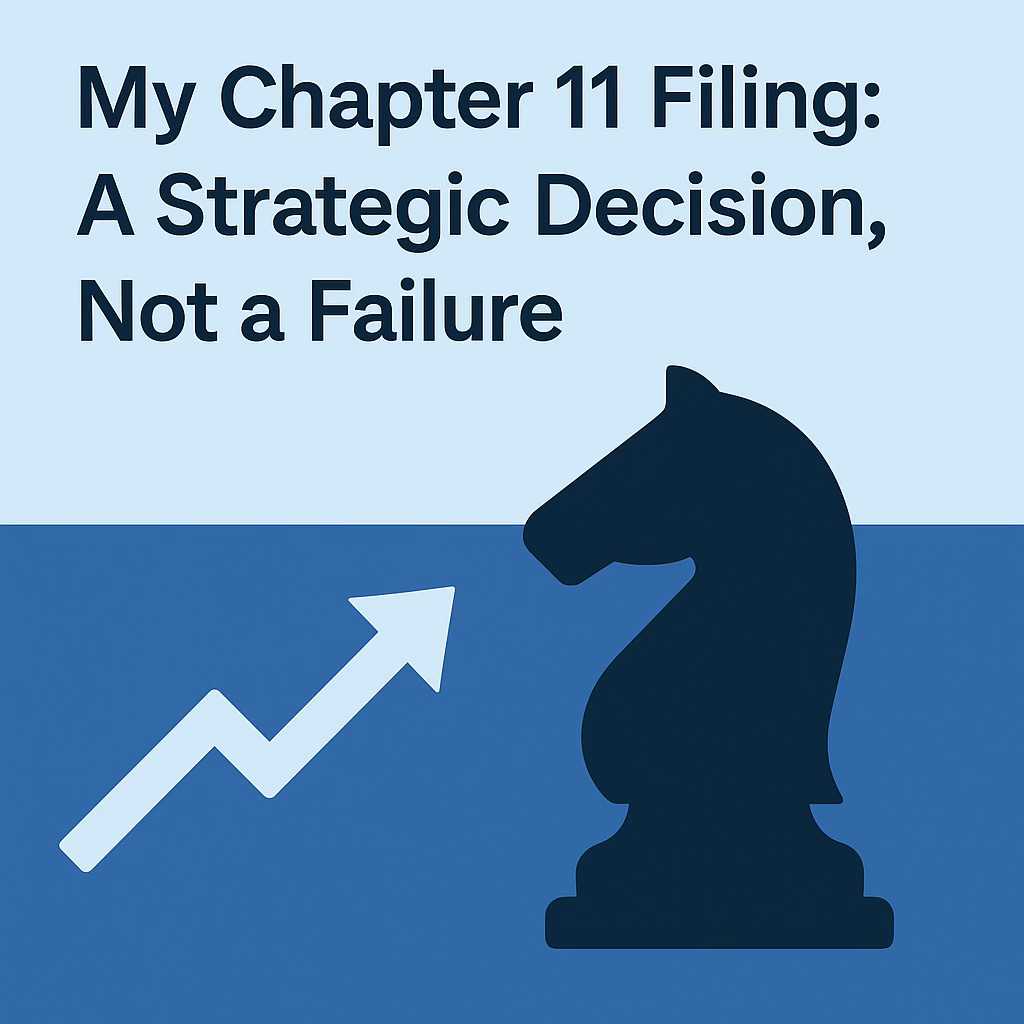My Chapter 11 Filing: A Strategic Decision, Not a Failure
By Rafael Benavente
My Chapter 11 Filing: A Strategic Decision, Not a Failure
In the world of entrepreneurship and real estate investing, risks are inevitable, and the pathway to success is rarely a straight line. For me, filing for Chapter 11 bankruptcy was not an admission of defeat—it was a calculated, legal, and strategic step toward preserving value, protecting assets, and preparing for future growth.
Chapter 11 is a restructuring tool available to individuals and businesses alike. While the term "bankruptcy" often evokes fear and stigma, the truth is that many of the most successful businesspeople in history have used Chapter 11 as a means to reorient their financial lives and emerge stronger. In this blog, I want to share the logic behind my decision, dispel misconceptions, and explain how this process is paving the way for sustainable recovery.
Understanding Chapter 11: More Than a Safety Net
Chapter 11 of the U.S. Bankruptcy Code is designed to allow debtors to reorganize their finances under the protection of the bankruptcy court. This process differs significantly from Chapter 7 liquidation bankruptcy. Under Chapter 11, the debtor remains in control of their assets and continues operations while negotiating with creditors to restructure debts.
For me, Chapter 11 meant I could press pause on aggressive creditor actions—like foreclosure and collection lawsuits—while maintaining control of my businesses and assets. It’s a legal breathing room, not a white flag.
Why I Filed: Strategic Objectives and Protection
There were three main reasons for my filing:
1. **Asset Protection**: I hold interests in real estate, including residential and commercial properties. Chapter 11 allowed me to safeguard these from imminent foreclosure while proposing a payment plan that reflects current market realities.
2. **Creditor Negotiation**: Some creditors, especially private lenders, were unwilling to compromise. Through Chapter 11, all parties must engage under court supervision.
3. **Operational Continuity**: Filing gave me time to reassess, regroup, and optimize business operations without the constant pressure of lawsuits, liens, or judgments.
Addressing the Public Misconception
One of the harshest aspects of modern bankruptcy is the online trail it leaves. Aggregator websites like BKData, Trellis, and UniCourt make public filings searchable by anyone with a smartphone. Unfortunately, these platforms often provide no context or updates on resolution, making listings appear scandalous when they are merely procedural.
For example, my case—listed by name, location, and date—pops up on several sites. But what they don’t show is that I’ve retained control of my properties, that many debts are being paid in accordance with the court-approved plan, and that the filing was strategic, not desperate.
A Tool Used by Smart Business Owners
Many of the world’s most iconic entrepreneurs have filed for bankruptcy protection—Walt Disney, Henry Ford, and Donald Trump among them. The idea is not to run away from obligations but to create a plan that works.
In my case, it also created an opportunity to reorganize the ownership structure of assets, seek new financing partners, and ultimately recover equity. Without Chapter 11, these strategic pivots wouldn’t be possible.
Lessons Learned and What Comes Next
The Chapter 11 process is not easy. It requires full transparency, strict court oversight, and a willingness to compromise. But I’ve learned to:
- Communicate more clearly with lenders and partners
- Improve financial reporting and documentation
- Focus on the core income-generating aspects of my business
Looking ahead, my plan is to finish the reorganization, build liquidity, and re-establish credit. The real estate I’ve protected will form the foundation for future projects—and I’ll be sharing updates on this blog along the way.
Transparency as a Defense
I believe in meeting misinformation head-on. When search engines show my name linked to a bankruptcy case, I want readers to find this blog explaining the real story. That’s why I’ve included my name in the title, used clear keywords, and made this content public.
For others going through something similar—whether it’s a business downturn or a legal issue—know that owning your narrative is the best way to move forward.
Conclusion: A Turning Point, Not an End
To anyone reading this who may be facing financial hardship, I want to say: bankruptcy is not a shameful escape—it’s a structured recovery process. For me, filing Chapter 11 was a rational, protective, and ultimately empowering step.
And to the search engines and data scrapers: context matters. I stand by my decisions and will continue to speak out against misleading court listings and promote transparency.
Stay tuned for updates on my progress and insights from the process. Chapter 11 isn’t where my story ends—it’s where the next chapter begins.
By Rafael Benavente

